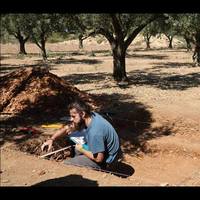Quim Sisa López de Pablo
Universitat Autònoma de Barcelona, Departament de Prehistòria, Department Member
- Neolithic and Chalcolitic, Ethnoarchaeology, Metallurgy, Ancient Near East, Prehistoric Archaeology, Geoarchaeology, and 24 moreLithic Technology, Neolithic & Chalcolithic Archaeology, Copper age, Archaeological Method & Theory, Prehistoric Technology, Prehistory Metallurgy, Economic archaeology, Political Economy, Economic History, Near Eastern Archaeology, Neolithic Archaeology, Archaeometallurgy, Ancient Metallurgy, Bronze Age Europe (Archaeology), Ancient Mining and Metallurgy, Archaeological Stratigraphy, Sedimentary geology and stratigraphy, Archaeological Soil Micromorphology, Landscape Archaeology, Geoarchaeology and Paleoenvironmental Reconstructions, Formation processes (Geoarchaeology), Archaeological Site Formation Processes, Sedimentology, and Micromorphologyedit
- #Prehistory #SouthwestAsia #geoarchaeology #micromorphology #siteformationprocesses
quimsisa@gmail.comedit
Fieldwork carried out at the site of Tell Halula, a settlement in the middle Euphrates valley (Syria), has allowed detailed analysis of the stratigraphy, together with a study of the sedimentological composition and other analytical... more
Fieldwork carried out at the site of Tell Halula, a settlement in the middle Euphrates valley (Syria), has allowed detailed analysis of the stratigraphy, together with a study of the sedimentological composition and other analytical approaches to the formation of the tell. In this contribution, the main characteristics of these processes are analysed and discussed, differentiating above all between architectural phases (earthen architecture with both domestic and monumental evidence), occupation levels (life/activity episodes) and taphonomic dynamics.
Research Interests:
The aim of this work is to know the role metallurgy played in protohistoric societies, specifically in the communities of the Ninevite V horizon. Unlike the communities of southern Mesopotamia, where society lived under a state... more
The aim of this work is to know the role metallurgy played in protohistoric societies, specifically in the communities of the Ninevite V horizon. Unlike the communities of southern Mesopotamia, where society lived under a state organization and metal acted as a valuable element, the north presents a different social scenario. Regarding metallurgy, given that communities in the north were closer to the mineral sources, this work researched whether this had any influence on their socioeconomic systems. Finally, we present the first results of the fieldwork developed at Tell Lashkir (Erbil, Kurdistan, Iraq) which provide new information about the Ninevite V communities located in northern Iraq, where research could not be carried out until 2011 for political reasons. Tell Lashkir is the archaeological site where the Seminari de Prehistoria de Próxim Orient from the Departament de Prehistoria of Universitat Autonoma de Barcelona carries out its fieldwork under the project “Proceso de transferencia e interacción social en el Neolítico del Próximo Oriente: Estudio de los ámbitos del valle del Éufrates y altiplanos del Zagros” in cooperation with the General Directorate of Antiquities of Kurdistan and the Archaeological Department of the Salahaddin University (Erbil).
Research Interests:
Recent archaeological fieldwork carried out at Tell Lashkir (Erbil, Iraq) by the Universitat autónoma de Barcelona and the Salahaddin University recovered an important set of metal items. Iron, bronze and copper objects such as knives,... more
Recent archaeological fieldwork carried out at Tell Lashkir (Erbil, Iraq) by the Universitat autónoma de Barcelona and the Salahaddin University recovered an important set of metal items. Iron, bronze and copper objects such as knives, pins or tokens were located in different contexts (grave goods in burials, domestic units, pits with special uses and other stratigraphic refillings). Furthermore, basic tools for the practice of metallurgy such a stone mould with evidence of thermic alteration have been identified.
